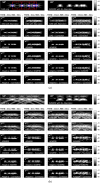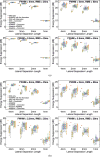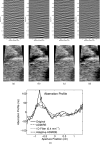The Impact of Model-Based Clutter Suppression on Cluttered, Aberrated Wavefronts
- PMID: 28742033
- PMCID: PMC5656016
- DOI: 10.1109/TUFFC.2017.2729944
The Impact of Model-Based Clutter Suppression on Cluttered, Aberrated Wavefronts
Abstract
Recent studies reveal that both phase aberration and reverberation play a major role in degrading ultrasound image quality. We previously developed an algorithm for suppressing clutter, but we have not yet tested it in the context of aberrated wavefronts. In this paper, we evaluate our previously reported algorithm, called aperture domain model image reconstruction (ADMIRE), in the presence of phase aberration and in the presence of multipath scattering and phase aberration. We use simulations to investigate phase aberration corruption and correction in the presence of reverberation. As part of this paper, we observed that ADMIRE leads to suppressed levels of aberration. In order to accurately characterize aberrated signals of interest, we introduced an adaptive component to ADMIRE to account for aberration, referred to as adaptive ADMIRE. We then use ADMIRE, adaptive ADMIRE, and conventional filtering methods to characterize aberration profiles on in vivo liver data. These in vivo results suggest that adaptive ADMIRE could be used to better characterize a wider range of aberrated wavefronts. The aberration profiles' full-width at half-maximum of ADMIRE, adaptive ADMIRE, and postfiltered data with 0.4- mm-1 spatial cutoff frequency are 4.0 ± 0.28 mm, 2.8 ± 1.3 mm, and 2.8 ± 0.57 mm, respectively, while the average root-mean square values in the same order are 16 ± 5.4 ns, 20 ± 6.3 ns, and 19 ± 3.9 ns, respectively. Finally, because ADMIRE suppresses aberration, we perform a limited evaluation of image quality using simulations and in vivo data to determine how ADMIRE and adaptive ADMIRE perform with and without aberration correction.
Figures













References
-
- Bushberg JT, Boone JM. The essential physics of medical imaging. Lippincott Williams & Wilkins; 2011.
-
- Anderson ME, Trahey GE. The direct estimation of sound speed using pulse–echo ultrasound. The Journal of the Acoustical Society of America. 1998;104(5):3099–3106. - PubMed
-
- Anderson M, McKeag M, Trahey G. The impact of sound speed errors on medical ultrasound imaging. The Journal of the Acoustical Society of America. 2000;107(6):3540–3548. - PubMed
-
- Flax S, O’Donnell M. Phase-aberration correction using signals from point reflectors and diffuse scatterers: Basic principles. Ultrasonics, Ferroelectrics, and Frequency Control, IEEE Transactions on. 1988;35(6):758–767. - PubMed
Publication types
MeSH terms
Grants and funding
LinkOut - more resources
Full Text Sources
Other Literature Sources
Research Materials
Miscellaneous

